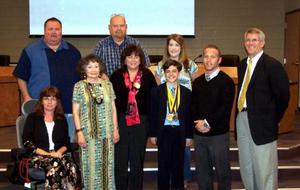
The MUSD governing board celebrated student achievement and volunteerism Wednesday evening, but they also heard plans for corrective action for Maricopa Wells Middle School, dissolved the ad hoc budget committee and reduced a number of classified staff positions for the 2010-2011 school year.
Student achievements
Desert Wind Middle School student Austen Pearce, 12, was Arizona’s winner in the Prudential program, which honors one middle school student and one high school student from each of the 50 states and the District of Columbia. He received $1,000 and a silver medal at that time. Pearce and his mother were in Washington, D.C. the first week of May; there he was named one of 10 Prudential gold medal winners, receiving $5,000 for his 100 plus volunteer hours spent designing, growing and tending a community garden to provide fresh produce for the F.O.R. Maricopa food bank, where Pearce also volunteers.
Pearce called his win “the first greatest experience in my life up to now,” and added that he hoped Desert Wind Principal Joe Veres, who nominated him, “will have the opportunity to nominate other students in the fall.”
The governing board also recognized all students who participated in the Academic League competitions this year. Pima Butte Elementary fourth and fifth graders swept the championship round and received a traveling trophy to hold until next year. Each student received a medal and a certificate.
MHS principal June Celaya announced the school’s culinary arts progarm has received a Banner of Excellence from CAVIT. In addition, seven students from HOSA (Health Organizations Students of America) went to state competition. Ayesha Hughes took first in nutrition and Mario Bandin took home honors in dental terminology. Both students, accompanied by adviser Lisa Gandolphi, will be going to national competition in Orlando, Fla. in June.
Bond sales
Business director Aron Rausch explained that the district has received an A+ bond rating during a third party review, showing the district’s “financial stability.” District bonds totaling $3.1 million were sold at a New York office Wednesday at 4.9 percent interest. Bond monies will be used to pay for the transportation facility ($1.9 million) and the performing arts building ($9 million) with approximately $1.3 million remaining, and $2,089 allocated in adjacent ways for utilities, parking lots and street work.
Volunteer program
Coordinator Margaret Jackson reported that volunteers have saved the district approximately $312,000 in unpaid service hours. About 500 volunteers are active with over 850 registered. Volunteer positions included five animal therapy teams, seven coaches, 23 reading buddies, 47 classroom volunteers, nine translators and 53 lifestyle volunteers. Jackson emphasized the growth of the program, telling the board, “We need to have a district plan to utilize the resources we have.”
Community facilities usage fee schedule
Board members approved the modified schedule, submitted by a facilities committee, based on four classifications. Class III or non-profit groups, like churches, will pay $2 per hour or $10 per day for a standard classroom, based on 1,000 square feet of facility space. Churches in Maricopa use district facilities about 7,000 hours each year. Class IV (for profit groups) will pay $4 per hour or $20 per day for a classroom space. Other facilities and playing fields have higher fees.
Ad Hoc budget committee
Due to the difficulty in getting 27 members for a quorum, resignations and the lack of commitment on the part of some committee members, board members voted (3-2) to dissolve this committee, establishing an advisory budget planning committee, which will report to the board. Members will come from the ad hoc committee’s roster. The new group is scheduled to meet May 19 in a work-study session with board members.
Reduction of classified personnel
Recommended reductions in the classified workforce were approved with some exceptions. Nine library aide/bookstore clerk positions were tabled, as well as middle school mentor and security postions and remaining custodial staff members. Board members did not approve the reduction of the three Maricopa Wells front office positions, the high school receptionist or the high school security position.
Maricopa Wells corrective action plan
The district has one year before a corrective action plan must be initiated at Maricopa Wells Middle School due to its under-performing student status. Greg Copeland and Joseph Hinz from the Arizona Department of Education explained to the governing board what that plan would entail.
“You need some serious interventions,” said Copeland. “The administrative team needs to make hard decisions and must have support from the board down. You have to change the culture of the school.”
Hinz recommended a complete change in staff, “poaching” good teachers from other schools and moving some of the Maricopa Wells teachers out. “Everyone on staff has to know how to use data and analyze data,” he said. “Traditionally, teachers close the door and teach, but education is different today. Everyone has to buy into the system and be trained, so you may have to add professional development days.”
Board member Tim White asked, “If you completely change every employee at the school, how much time to turn it around?” Copeland indicated that there would be substantial change in year two and a drastic change in year three, going from performing to performing plus to excelling in that third year.
“Can one of the feeder schools, not in corrective action, go through the intervention process?” queried Superintendent Jeff Kleck. “It doesn’t do us much good to change one and not the other.”
“Board members are going to have to think outside the box also,” Hinz explained. “The community has to be sold on the fact that your strategies are going to benefit their children. The community has to be involved at every level.”
Both Copeland and Hinz agreed that the school improvement plan has to be a “living, breathing document,” offering their support for the board’s decisions, as well as a systematic approach to the plan.
“I hope we don’t wait another year,” said White.
“We can’t wait,” responded board president Geoff Goddard. “Now’s the time to strike.”
Photos by Joyce Hollis

![Who’s the Best Mom InMaricopa? Nominate now! Marlene Marshall, Christina Olivares, and Meghan Bremer. [Bryan Mordt]](https://www.inmaricopa.com/wp-content/uploads/2023/05/BCM_8465-218x150.jpg)



![Maricopa sheds tears amid Maui wildfires that killed dozens For Maricopa resident Janelle Gomez, the sorrow mirrors the loss of a family member. [Brian Petersheim]](https://www.inmaricopa.com/wp-content/uploads/2023/08/Gomez-218x150.jpg)
![Embracing Freedom: Celebrating the Fourth of July Councilmember Vincent Manfredi at Great American 4th 2021 [Victor Moreno]](https://www.inmaricopa.com/wp-content/uploads/2023/07/2021-Great-American-4th-e1688414543522-218x150.jpg)





![Alleged car thief released without charges Phoenix police stop a stolen vehicle on April 20, 2024. [Facebook]](https://www.inmaricopa.com/wp-content/uploads/2024/04/IMG_5040-218x150.jpg)




